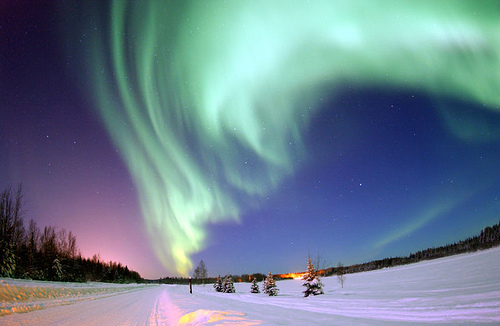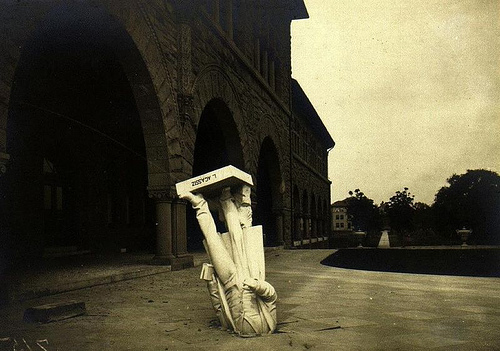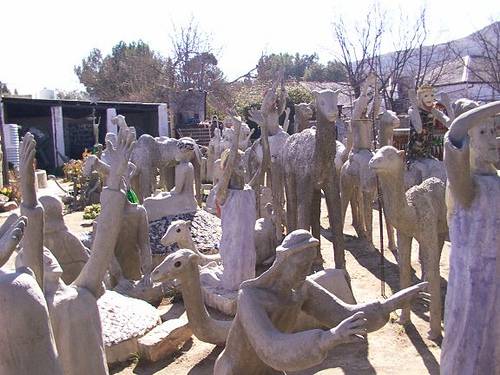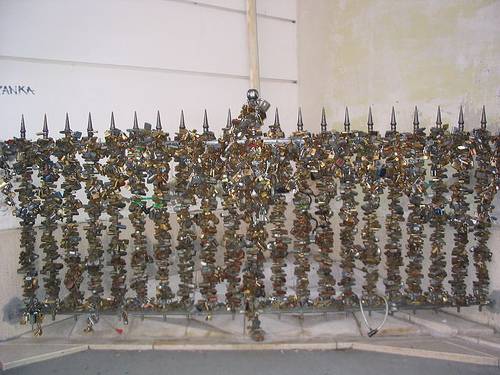Adam Rainer lived as both a dwarf and a giant. Born in 1899 in Austria, Rainer was 4 feet tall at age 18. Then, suddenly, he began to grow, stretching a full meter in the next 11 years to reach 7 feet 1.75 inches in 1931. The physical strain left him bedridden for life, but he kept growing. When he died in 1950 at age 51, Rainer had reached 7 feet 8 inches, having grown 44 inches during his adult years. Probably he had a pituitary tumor.
ATM Freeze
The world’s northernmost automatic teller machine is at Longyearbyen, Norway (78°13’N 15°33’E).
The southernmost is at McMurdo Station, Antarctica (77°51’S 166°40’E).
The Maine Penny
Digging in an old Indian settlement in 1957, Maine archaeologists turned up a silver penny that had been minted in Norway between 1065 and 1080 A.D.
That means either that ancient Norse had visited the region … or that the natives had quite an extensive trade network. An arctic Eskimo cutting tool was found at the same site.
Auroral Sounds

Ever since ancient Rome, people have reported hearing the aurora borealis. It’s been described as a crackling, hissing, buzzing, or whistling.
Modern science can’t explain such sounds (yet), and so far no one’s managed to record them, so for now the jury’s still out.
Related: In 1881, correspondent F.C. Constable wrote to Nature of walking home during an electric storm in Karachi when “I heard all round me the constant crackling or rustling of blazing flames. Towards the north-west across a low arc near the horizon pale sheet lightning swayed quickly to and fro. There was no rain at the time, that came heavily afterwards. The sound of flames was close round me, and others had the same experience. No one I can find has ever seen lightning so completely fill the air or heard such strange sounds.”
Doomsday Clock
Every issue of the Bulletin of the Atomic Scientists since 1947 has displayed a clock face on its cover, symbolizing the world’s proximity to nuclear war (in the judgment of the bulletin’s board of directors).
At its most dire, the clock stood at two minutes to midnight in 1953, when the United States and the Soviet Union tested thermonuclear devices within nine months of one another. Thirty-eight years later, when the superpowers signed the START treaty in 1991, the clock reached 17 minutes to midnight, its most hopeful position to date.
That doesn’t mean we’re making progress. Today it stands at 7 minutes to midnight — which is just where it started 59 years ago.
Field Work

Stanford University after the earthquake of 1906.
The statue is of Louis Agassiz … who studied geology.
In a Word
ucalegon
n. a neighbor whose house is on fire
Charley Parkhurst
Excerpt from an obituary for stagecoach driver Charley Parkhurst, published in the San Francisco Morning Call, Dec. 28, 1879:
He was in his day one of the most dexterous and celebrated of the famous California drivers ranking with Foss, Hank Monk, and George Gordon, and it was an honor to be striven for to occupy the spare end of the driver’s seat when the fearless Charley Parkhurst held the reins of a four- or six-in-hand …
It was discovered only afterward that “One-Eyed Charlie” had been a woman, born Charlotte Darkey Parkhurst in Vermont in 1812. Posing as a man, she had gained a reputation as one of the best stagecoach drivers on the West Coast.
More than that, her name (as Charles Darkey Parkurst) is listed in the Santa Cruz voter rolls for Oct. 17, 1868 — which means she may have been the first woman to vote in California.
The Owl House

Deciding that her life was “dull,” Helen Martins went a little crazy in 1945 and began filling her garden with sculptures of owls, camels and people. She said she drew her inspiration from Blake, the Bible and Omar Khayyam, but she also pointed most of the figures eastward to reflect an obsession with the Orient. And she decorated the house’s interior walls with crushed glass.
Martins was derided during her lifetime, but the house has been preserved and is now a national monument in South Africa.
Love Padlocks

In the 1980s, in the Hungarian city of Pécs, lovers began to clamp padlocks to this wrought-iron fence as a symbol of their commitment.
Now that the fence has filled up, people have begun attaching locks to fences and statues throughout the town center, and the custom has spread to Hungary, Latvia, Italy and Japan.
“Love is a lock that linketh noble minds,” wrote Robert Greene, “faith is the key that shuts the spring of love.”
